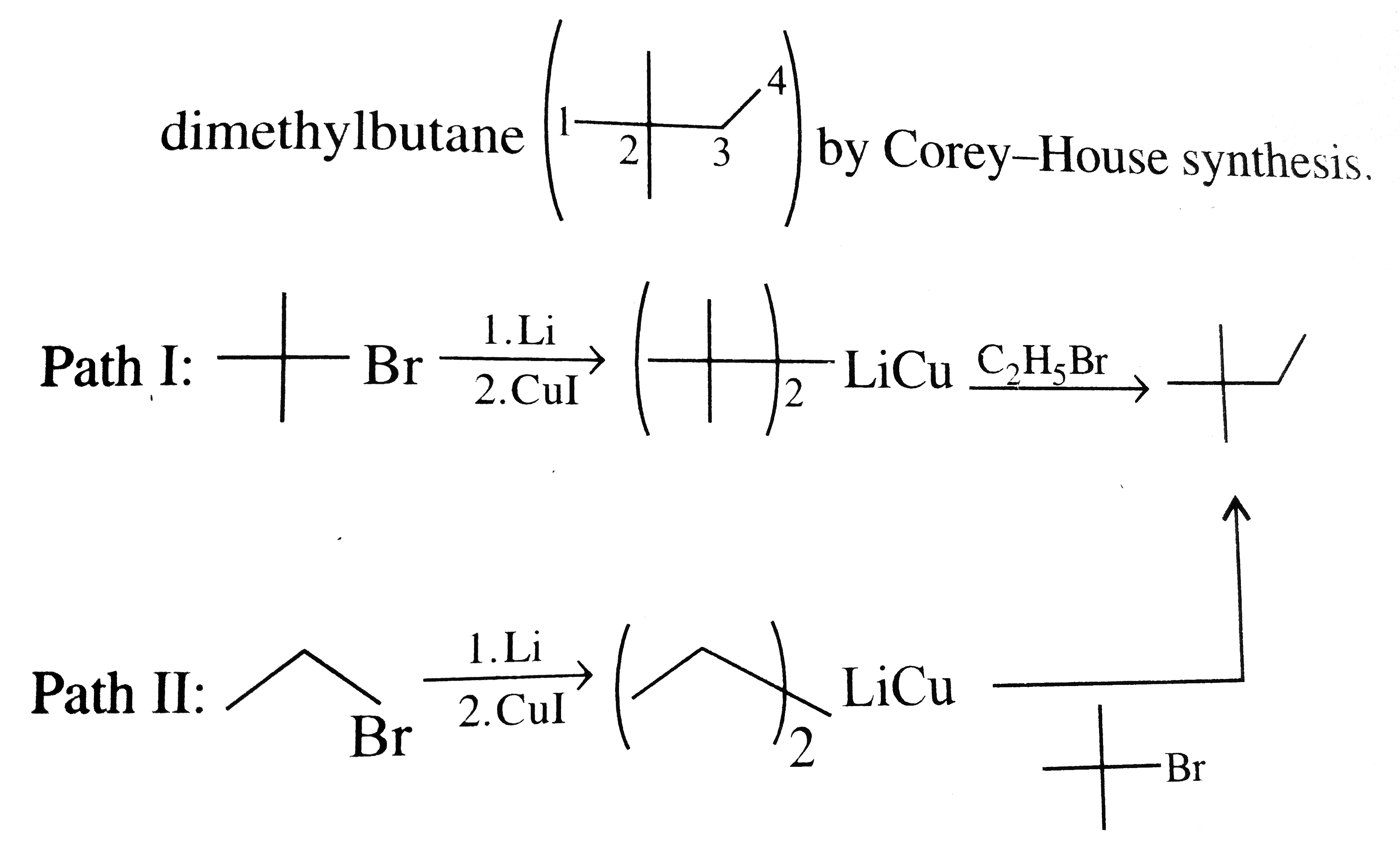Corey-House reaction.
Step-by-Step Solution for Corey-House Reaction
Step 1: Formation of Alkyl Lithium
- Start with an alkyl halide (R-X), where R is an alkyl group and X is a halogen (like Cl, Br, or I).
- React the alkyl halide with lithium metal (Li) in an ether solvent.
- The reaction will produce alkyl lithium (R-Li) and lithium halide (Li-X).
Reaction:
R−X+2Liether−−−→R−Li+LiX
Step 2: Formation of Organocopper Reagent
- Take the alkyl lithium (R-Li) formed in Step 1 and react it with copper(I) iodide (CuI) in the same ether solvent.
- This reaction will yield a lithium organocopper compound (R2CuLi).
Reaction:
R−Li+CuIether−−−→R2CuLi
Step 3: Reaction with Alkyl Halide
- Use the lithium organocopper compound (R2CuLi) to react with a primary alkyl halide (R'-X).
- This reaction occurs via an SN2 mechanism, where the organocopper acts as a nucleophile and attacks the carbon atom bonded to the halogen in the alkyl halide, resulting in the formation of a new carbon-carbon bond.
Reaction:
R2CuLi+R′−Xether−−−→R−R′+CuX+LiX
Final Product:
- The final product of the Corey-House reaction is a new hydrocarbon (R-R') along with byproducts, which include copper halide (CuX) and lithium halide (LiX).
Summary of the Corey-House Reaction
1. Alkyl halide reacts with lithium in ether to form alkyl lithium.
2. Alkyl lithium reacts with CuI to form organocopper reagent.
3. Organocopper reagent reacts with a primary alkyl halide to form a new hydrocarbon and byproducts.
---
- Start with an alkyl halide (R-X), where R is an alkyl group and X is a halogen (like Cl, Br, or I).
- React the alkyl halide with lithium metal (Li) in an ether solvent.
- The reaction will produce alkyl lithium (R-Li) and lithium halide (Li-X).
Reaction:
R−X+2Liether−−−→R−Li+LiX
- Take the alkyl lithium (R-Li) formed in Step 1 and react it with copper(I) iodide (CuI) in the same ether solvent.
- This reaction will yield a lithium organocopper compound (R2CuLi).
R−Li+CuIether−−−→R2CuLi
- Use the lithium organocopper compound (R2CuLi) to react with a primary alkyl halide (R'-X).
- This reaction occurs via an SN2 mechanism, where the organocopper acts as a nucleophile and attacks the carbon atom bonded to the halogen in the alkyl halide, resulting in the formation of a new carbon-carbon bond.
R2CuLi+R′−Xether−−−→R−R′+CuX+LiX
- The final product of the Corey-House reaction is a new hydrocarbon (R-R') along with byproducts, which include copper halide (CuX) and lithium halide (LiX).
1. Alkyl halide reacts with lithium in ether to form alkyl lithium.
2. Alkyl lithium reacts with CuI to form organocopper reagent.
3. Organocopper reagent reacts with a primary alkyl halide to form a new hydrocarbon and byproducts.
Topper's Solved these Questions
Similar Questions
Statement-1: Corey-House reaction can be used to prepare both symmetrical and unsymmetrical alkanes.
Statement-2: The reaction involves the interaction between lithium dialkyl copper with an alkyl halide both of which may contain even or odd number of carbon atoms.
View SolutionThere are two ways for the preparation of 2,2-dimethylbutane
 by Corey - House synthesis.
by Corey - House synthesis.
Which of the following statements is correct ?
View Solution
Knowledge Check
Which of the folowing alkyl halides is not suitable for Corey-House synthesis of alkanes?
ACH3IB C
C D
D
They _________the whole house repainted.
AhaveBhadChasDnone of these
R2CuLi is the intermediate formed in Corey House synthesis, and is known as
View SolutionGreen-house effect is warming due to
View SolutionDiscuss in brief Green House effect.
View SolutionThe reason for green-house effect is
View SolutionUsing corey - house synthesis we can't prepare ………………….. from ethylbromide.
View SolutionThe houses of a row are numbered consecutively from 1 to 49. Show that there is a value of x such that the sum of the numbers of the houses preceding the house numbered x is equal to the sum of the numbers of the houses following it. Find this value of x.
View Solution